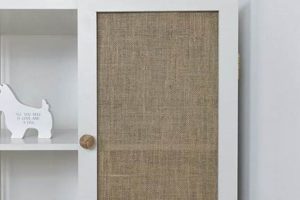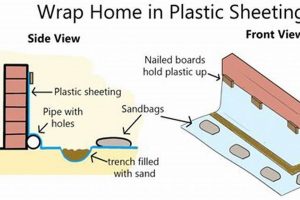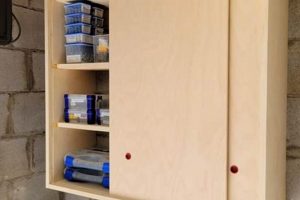Festive adornments for the entryway, crafted at home, present an opportunity to personalize the holiday welcome. These decorations, frequently involving handmade elements, offer a unique alternative to commercially produced items. Examples include wreaths constructed from foraged greenery, garlands made of felt or paper, and repurposed ornaments artfully arranged to create a visual statement.
The significance of such embellishments extends beyond mere aesthetic appeal. The process of creating them fosters a sense of engagement with the season, promoting creativity and resourcefulness. Historically, homemade decorations have been integral to holiday celebrations, reflecting cultural traditions and individual artistic expression. Furthermore, using recycled or natural materials in these projects aligns with sustainable practices and reduces environmental impact.
The subsequent sections will explore various types of self-made entryway adornments, focusing on materials, techniques, and design principles relevant to achieving visually appealing and durable results. Consideration will be given to adaptations suitable for different architectural styles and levels of crafting expertise.
Guidelines for Festive Entryway Projects
The following recommendations are designed to assist in the creation of durable and aesthetically pleasing holiday entryway embellishments. Adherence to these principles will enhance both the visual impact and longevity of the finished product.
Tip 1: Material Selection: Choose materials appropriate for exterior exposure. Natural elements, such as evergreen boughs or pinecones, should be properly dried to prevent premature decay. Weather-resistant fabrics and paints are essential for maintaining color and structural integrity.
Tip 2: Structural Integrity: Ensure a robust framework for any hanging decoration. A sturdy wire wreath form, a well-constructed wooden base, or reinforced mounting points are crucial for preventing damage from wind or weight. Securely attach all components using weather-resistant adhesives or fasteners.
Tip 3: Color Palette Coordination: Establish a cohesive color scheme that complements the existing exterior architecture and landscaping. Restricting the color palette to a limited range, such as variations of red, green, and gold, creates a visually harmonious effect. Consider the impact of natural lighting on color perception.
Tip 4: Proportion and Scale: Carefully consider the dimensions of the entryway and the surrounding area when determining the size and scale of the decoration. An oversized ornament may overwhelm a small porch, while a diminutive design may be lost on a grand facade. Maintain visual balance.
Tip 5: Illumination Integration: Incorporate lighting elements to enhance visibility during evening hours. Battery-operated LED lights are a safe and energy-efficient option. Conceal wiring and battery packs to maintain a clean aesthetic. Ensure that electrical components are rated for outdoor use.
Tip 6: Regular Maintenance: Periodically inspect the decorations for signs of wear or damage. Replace faded or broken elements promptly. Remove debris, such as leaves or snow, to maintain a polished appearance and prevent potential hazards.
These guidelines, when implemented thoughtfully, contribute to the creation of entryway embellishments that are not only visually appealing but also durable and safe. By prioritizing material quality, structural integrity, and design considerations, one can elevate the holiday ambiance of the home.
The concluding section will offer further resources and inspiration for designing unique and personalized holiday entryway decor.
1. Material Durability
Material durability is paramount when constructing festive entryway adornments, as these decorations are invariably exposed to environmental elements. The selection of resilient materials directly impacts the lifespan and visual appeal of the project. Failure to consider material properties can result in premature degradation, necessitating frequent repairs or replacements, thereby diminishing the overall cost-effectiveness of the endeavor.
- Weather Resistance
This refers to a material’s ability to withstand exposure to precipitation, temperature fluctuations, and ultraviolet radiation. Exterior-grade paints, treated woods, and waterproof fabrics are examples of weather-resistant materials. Untreated natural materials, such as certain types of foliage, may rapidly decompose or discolor when subjected to prolonged exposure, compromising the aesthetic integrity of the decoration.
- Structural Integrity
The chosen materials must possess sufficient strength to support their own weight and withstand external forces, such as wind. Lightweight materials may be suitable for sheltered locations, while heavier or more robust materials are necessary for exposed areas. Inadequate structural integrity can lead to deformation, breakage, or detachment of components, posing a potential safety hazard.
- Resistance to Degradation
Certain materials are susceptible to degradation from biological factors, such as mold, mildew, or insect infestation. Proper treatment or selection of inherently resistant materials is essential for preventing this type of damage. For instance, using pressure-treated lumber or applying protective coatings can mitigate the risk of decay in wooden elements.
- Colorfastness
Many dyes and pigments are not inherently resistant to fading when exposed to sunlight. Selecting materials with good colorfastness ensures that the decoration retains its vibrant appearance over time. Pigments specifically formulated for outdoor use offer enhanced resistance to UV degradation. The use of colorfast materials minimizes the need for frequent repainting or replacement.
The interconnectedness of these facets underscores the critical role of material durability in the success of any entryway decoration. By carefully considering these properties, creators can ensure that their festive projects remain visually appealing and structurally sound throughout the holiday season and beyond. Neglecting material durability can lead to disappointment, increased costs, and potential safety concerns. Therefore, a thorough assessment of material properties is an indispensable step in the crafting process.
2. Aesthetic Harmony
Aesthetic harmony, in the context of festive entryway adornments, refers to the cohesive integration of visual elements that contribute to a unified and pleasing appearance. Its achievement is vital for maximizing the impact of self-made decorations, ensuring they enhance rather than detract from the overall aesthetic of the dwelling.
- Color Palette Synchronization
The selection of a coordinated color scheme is fundamental. Colors should complement the existing facade, architectural details, and surrounding landscape. Employing analogous colors, such as varying shades of green and blue, or complementary colors, such as red and green in moderation, creates visual interest without discord. Incongruous color choices can result in a jarring or visually chaotic effect, diminishing the perceived quality of the decoration.
- Stylistic Coherence
The design style of the decoration should align with the architectural style of the building. A minimalist, modern home benefits from streamlined decorations, while a Victorian residence may accommodate more ornate designs. A mismatch in styles can create a sense of dissonance and undermine the intended aesthetic appeal. For example, a rustic, burlap-themed wreath might clash with a sleek, contemporary entrance.
- Scale and Proportion Appropriateness
The size and scale of the decoration must be proportional to the dimensions of the entryway. An oversized wreath on a small door overwhelms the space, while an undersized decoration on a large door appears insignificant. Careful consideration of scale ensures visual balance and prevents the decoration from appearing disproportionate or out of place.
- Textural Integration
The use of varied textures can add depth and visual interest, but these textures should be selected judiciously to avoid creating a cluttered or disjointed appearance. Combining smooth and rough textures, such as polished ornaments with natural foliage, can create a tactile and visually appealing contrast. However, an excessive number of competing textures can result in visual overload.
Integrating these elements contributes to aesthetic harmony in entryway ornamentation. A synchronized color palette, stylistic coherence, appropriate scale and proportion, and judicious use of texture collectively elevate the visual appeal, transforming a simple decoration into an integral feature of the seasonal landscape.
3. Structural Integrity
Structural integrity constitutes a foundational requirement for any “christmas diy door decorations” intended for exterior display. Its absence invariably leads to premature failure, manifesting as component detachment, deformation under wind load, or complete collapse. The cause-and-effect relationship is direct: inadequate structural design yields decorations susceptible to environmental stressors, negating aesthetic appeal and potentially creating safety hazards. The practical significance lies in safeguarding both the visual impact and the physical security associated with holiday adornments.
Consider a wreath constructed using a lightweight wire frame and poorly adhered embellishments. Under moderate wind conditions, ornaments may detach, ribbons unravel, and the frame itself may distort, rendering the wreath unsightly and requiring immediate repair. Conversely, a wreath built upon a robust, reinforced frame, with securely fastened elements and weather-resistant adhesives, will maintain its form and integrity throughout the season, providing a durable and visually pleasing entryway accent. Another example involves garlands: a garland strung with fragile, easily broken ornaments will quickly lose its decorative value, whereas one assembled with shatterproof ornaments and strong, weather-resistant cording will endure exposure to the elements without significant degradation.
In summary, structural integrity directly influences the longevity, safety, and aesthetic value of festive entryway embellishments. Prioritizing robust materials, secure construction methods, and appropriate reinforcement techniques mitigates the risk of premature failure, ensuring that “christmas diy door decorations” effectively contribute to the festive ambiance without compromising safety or incurring unnecessary maintenance costs. The durability stemming from solid structural design is an inseparable aspect of successful holiday decor.
4. Design Simplicity
Design simplicity, as applied to “christmas diy door decorations,” emphasizes minimizing complexity in both the conceptualization and execution phases. This principle directly affects project feasibility, cost-effectiveness, and overall aesthetic impact. Elaborate designs, while potentially visually striking, often necessitate specialized skills, expensive materials, and extensive time commitments. This increased complexity elevates the risk of errors during construction and can lead to project abandonment or substandard results. Conversely, simple designs, characterized by clear lines, minimal components, and straightforward assembly techniques, facilitate broader accessibility and minimize potential points of failure. The cause-and-effect relationship is clear: simplified designs lower the barrier to entry, encouraging participation and increasing the likelihood of successful project completion. This is directly connected to the importance of “Design Simplicity” as a crucial part of “christmas diy door decorations.”
Consider the common example of a simple evergreen wreath adorned with a limited number of ornaments and a single, impactful bow. This design requires minimal skill, utilizes readily available materials, and can be assembled quickly. The aesthetic impact derives from the careful selection of complementary colors and textures, rather than intricate craftsmanship. In contrast, a complex wreath incorporating multiple layers of varying materials, intricate wiring patterns, and custom-fabricated elements demands specialized knowledge and significant time investment. The practical application of design simplicity extends beyond cost and time considerations; it also enhances the overall visual coherence of the decoration. A clean, uncluttered design allows the individual elements to stand out, creating a more impactful and aesthetically pleasing result. Furthermore, simpler designs often prove more durable, as there are fewer intricate components susceptible to damage or detachment. Consider another example: a minimalist star crafted from reclaimed wood, requiring only basic cutting and joining skills. This project is both aesthetically appealing and environmentally conscious, demonstrating the potential for design simplicity to enhance creativity and sustainability.
In conclusion, design simplicity is a critical determinant of success in crafting “christmas diy door decorations.” It fosters accessibility, reduces costs, minimizes complexity, and enhances aesthetic coherence. The adoption of simplified design principles empowers individuals of varying skill levels to create visually appealing and durable decorations, maximizing the enjoyment and satisfaction derived from the crafting process. This design principle may seem elementary, but recognizing and incorporating simple designs contributes to the overall festive ambiance without requiring excessive resources or specialized expertise. The benefit stemming from simple designs is an inseparable element of successful holiday decor.
5. Cost Effectiveness
Cost effectiveness is a primary motivator and consequential outcome of engaging in self-made holiday entryway adornments. This principle directly influences the accessibility of festive decorations, enabling individuals and families to participate in seasonal celebrations without incurring significant financial burdens. The causal relationship between cost-effective crafting and widespread festive participation is clear: reduced financial constraints democratize access to holiday embellishments, fostering a more inclusive and widespread spirit of celebration. Understanding the importance of cost-effectiveness as a key component of “christmas diy door decorations” is paramount for maximizing both creative expression and budgetary responsibility. For instance, utilizing foraged natural materials, such as pinecones and evergreen branches, sourced at no cost, significantly reduces the overall expenditure. Similarly, repurposing existing materials, such as fabric scraps or outdated ornaments, transforms potential waste into valuable components of festive decorations, further enhancing cost savings.
Furthermore, the practical application of cost-effective principles extends beyond material selection. Simplifying design complexities and opting for readily available, inexpensive tools and techniques minimizes labor costs and reduces the likelihood of project-related expenses. For example, a basic wreath constructed from a wire coat hanger and adorned with hand-painted pinecones provides a visually appealing and festive decoration at a minimal cost. Conversely, purchasing commercially produced decorations often involves significant financial outlays, particularly for elaborate or personalized designs. Choosing self-made options, therefore, presents a tangible avenue for reducing holiday spending without sacrificing aesthetic appeal or festive spirit. The savings realized through cost-effective crafting can then be reallocated to other aspects of holiday celebrations, such as gift-giving or charitable contributions.
In conclusion, cost effectiveness plays a vital role in shaping the landscape of holiday entryway decorations. By prioritizing resourcefulness, simplicity, and the utilization of readily available materials, individuals can create visually appealing and festive embellishments without exceeding budgetary limitations. The inherent link between cost consciousness and self-made decorations fosters greater participation in seasonal celebrations and contributes to a more sustainable and economically responsible approach to holiday spending. Overcoming the misconception that appealing decor requires excessive spending empowers individuals to embrace their creativity and transform readily available materials into cherished holiday accents.
Frequently Asked Questions
This section addresses prevalent inquiries concerning the creation and maintenance of festive entryway decorations constructed using do-it-yourself methods. The information presented aims to clarify common misconceptions and provide practical guidance.
Question 1: What constitutes an appropriate timeframe for initiating the crafting of external holiday door decorations?
The ideal timeframe depends on the materials utilized. Decorations incorporating natural elements, such as evergreen branches, benefit from being assembled closer to the holiday to minimize desiccation. However, components requiring painting or significant assembly may be initiated several weeks in advance. Planning and material preparation should commence well before the intended display date.
Question 2: Is specialized expertise required to fabricate durable and aesthetically pleasing holiday entryway embellishments?
While advanced crafting skills can enhance the complexity and detail of decorations, proficiency in basic techniques, such as cutting, gluing, and wiring, is generally sufficient for creating visually appealing projects. Numerous online resources and tutorials provide step-by-step guidance for individuals of varying skill levels. Emphasis on design simplicity often mitigates the need for specialized expertise.
Question 3: How can one ensure that self-made decorations withstand adverse weather conditions?
The selection of weather-resistant materials is paramount. Exterior-grade paints, waterproof adhesives, and treated fabrics are essential for preventing damage from precipitation, temperature fluctuations, and ultraviolet radiation. Secure attachment of all components and robust structural framing contribute to overall durability. Regular inspection and maintenance are recommended to address any signs of wear or damage promptly.
Question 4: What methods exist for minimizing the environmental impact of creating holiday door decorations?
Employing recycled or repurposed materials, such as fabric scraps, discarded ornaments, or reclaimed wood, reduces waste and conserves resources. Utilizing natural, biodegradable elements, such as pinecones and evergreen branches, sourced responsibly minimizes environmental disruption. Opting for low-VOC paints and adhesives further reduces the ecological footprint of the project.
Question 5: What safety precautions should be observed when crafting and installing holiday entryway adornments?
When using power tools, appropriate safety gear, such as eye protection and gloves, should be worn. Ensure that all electrical components, such as lighting elements, are rated for outdoor use and installed according to manufacturer instructions. Securely fasten decorations to prevent detachment and potential hazards. Exercise caution when working at heights and utilize stable ladders or platforms.
Question 6: What constitutes an effective strategy for storing holiday entryway decorations to prolong their lifespan?
Thoroughly clean and dry decorations before storing them to prevent mold or mildew growth. Store items in airtight containers in a cool, dry location away from direct sunlight. Consider wrapping delicate components in protective materials, such as bubble wrap or acid-free tissue paper. Label storage containers clearly to facilitate easy retrieval in subsequent seasons.
The information presented in this FAQ section underscores the importance of thoughtful planning, material selection, and adherence to safety guidelines in the creation and maintenance of successful self-made holiday entryway embellishments.
The concluding section will offer a concise summary of key recommendations and insights discussed throughout this article.
Conclusion
This exposition has detailed the fundamental considerations for “christmas diy door decorations,” emphasizing the interplay between material durability, aesthetic harmony, structural integrity, design simplicity, and cost-effectiveness. The effective implementation of these principles ensures aesthetically pleasing, sustainable, and safe adornments suitable for diverse architectural styles and environmental conditions. Prioritization of these elements is crucial to realizing the full potential of self-made festive entryway enhancements.
As individuals and communities engage in seasonal celebrations, the principles outlined serve as a guide to responsible creativity. The enduring value of “christmas diy door decorations” lies not only in their visual appeal but also in their potential to foster resourcefulness, community engagement, and a deeper appreciation for the spirit of the season. Continued exploration and refinement of these crafting practices will contribute to richer, more sustainable holiday traditions.







